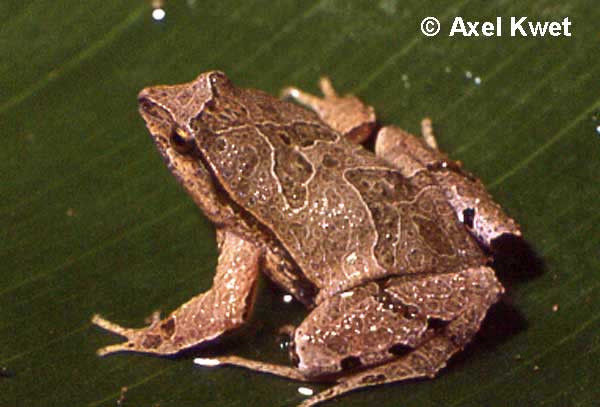
Physalaemus maculiventris (*)
Superregnum: Eukaryota
Cladus: Unikonta
Cladus: Opisthokonta
Cladus: Holozoa
Regnum: Animalia
Subregnum: Eumetazoa
Cladus: Bilateria
Cladus: Nephrozoa
Superphylum: Deuterostomia
Phylum: Chordata
Subphylum: Vertebrata
Infraphylum: Gnathostomata
Megaclassis: Osteichthyes
Cladus: Sarcopterygii
Cladus: Rhipidistia
Cladus: Tetrapodomorpha
Cladus: Eotetrapodiformes
Cladus: Elpistostegalia
Superclassis: Tetrapoda
Classis: Amphibia
Subclassis: Lissamphibia
Ordo: Anura
Familia: Leptodactylidae
Subfamilia: Leiuperinae
Genus: Physalaemus
Species: Physalaemus maculiventris
Name
Physalaemus maculiventris (Lutz, 1925)
Type locality: "montagnes, près de Santos", São Paulo, Brazil.
Syntypes: UMMZ 92444, USNM 96837-39, 96840, 96842-43.
Synonyms
Eupemphix maculiventris Lutz, 1925
Physalaemus maculiventris — Lutz, 1951
References
Lutz, 1925, C. R. Seances Soc. Biol., Paris, 93: 138.
Lutz, 1951, Mem. Oswaldo Cruz, Rio de Janeiro, 49: 669–683.
Frost, D.R. 2021. Amphibian Species of the World: an Online Reference. Version 6.1. Electronic Database accessible at https://amphibiansoftheworld.amnh.org/index.php. American Museum of Natural History, New York, USA. DOI: 10.5531/db.vz.0001 Physalaemus maculiventris . Accessed on 04 June 2008.
2007 IUCN Red List of Threatened Species IUCN: Physalaemus maculiventris (Least Concern) Downloaded on 04 June 2008.
Vernacular names
English: Mantagnes Dwarf Frog
Physalaemus maculiventris is a species of frog in the family Leptodactylidae.[1][2] It is endemic to Southeast and South Brazil and is known primarily from the Serra do Mar in Espírito Santo,[1] Rio de Janeiro, São Paulo state, Paraná, and Santa Catarina states.[1][2] Common name Mantagnes dwarf frog has been proposed for it.[2]
Description
Adult males measure 19–22 mm (0.7–0.9 in) and adult females 20–25 mm (0.8–1.0 in) in snout–vent length. The snout is pointed or pointed-subelliptical in dorsal view and acute or rounded-acute in profile. The tympanum is not visible. The finger and toe tips are rounded or slightly swollen but without discs; webbing is also absent. The dorsum is brown and tan with yellow outlining. The hands and feet have orange highlights. The iris is bronze. Males have a single vocal sac.[3]
Habitat and conservation
Physalaemus maculiventris occurs in primary and secondary forest at elevations of about 800 m (2,600 ft) above sea level; it can occur on the forest edge but not in more open areas. It is terrestrial frog usually found near temporary ponds or in the water. Breeding takes place in temporary ponds where a foam nest is built.[1]
Physalaemus maculiventris is a common species, but it can be threatened by habitat loss caused by agriculture, livestock grazing, clear-cutting, tourism, and human settlement. It is found in several protected areas.[1]
References
Magno Vicente Segalla, Oswaldo Luiz Peixoto (2004). "Physalaemus maculiventris". IUCN Red List of Threatened Species. 2004: e.T57263A11596049. doi:10.2305/IUCN.UK.2004.RLTS.T57263A11596049.en. Retrieved 16 November 2021.
Frost, Darrel R. (2020). "Physalaemus maculiventris (Lutz, 1925)". Amphibian Species of the World: An Online Reference. Version 6.1. American Museum of Natural History. doi:10.5531/db.vz.0001. Retrieved 27 May 2020.
Heyer, W. R.; Rand, A. S.; Cruz, C. A. G.; Peixoto, O. L. & Nelson, C. E. (1990). "Frogs of Boracéia". Arquivos de Zoologia. 31: 231–410. (Physalaemus maculiventris: pp. 315–316.)
Retrieved from "http://en.wikipedia.org/"
All text is available under the terms of the GNU Free Documentation License

